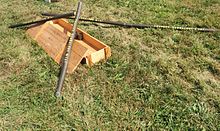Bangalore (bomb)
Bangalores are explosive devices designed as long, push-together tubes. They are used by pioneers and infantrymen to destroy barbed wire entanglements and to clear minefields.
The Bangalores were developed in 1912 by Captain McClintock, British Army , in the Indian city of Bangalore , after which the weapon was named. They were used to clear booby traps and barbed wire barriers left behind in the Second Boer War and the Russo-Japanese War . The big advantage was that the mine clearer could blast an alley through the minefield from a protected position (e.g. trenches) at a distance of about three meters. This procedure also allowed mine clearance under fire.
During the First World War, the Bangalores consisted of identical 1.5 m long rods that could be screwed together, the first of which contained the explosive device. A conical nose could also be screwed on at the beginning to prevent it from getting stuck.
During the Second World War, the weapons were used as the M1A1 Bangalore torpedo on a large scale on D-Day when the Allied troops landed in order to make the beaches that were cordoned off by the Germans passable for the infantry . In a slightly modified version of the M1A2 , they are still used.
The German Bundeswehr and the Swiss Army use a similar construction under the name Sprengrohr , which is increasingly being displaced by the detonating slider and detonating cord . These have the advantage that the pioneer can shoot them into the minefield from cover or from an armored vehicle using a throwing charge and then blow them up with the mines.
literature
- Swiss Army (Ed.): The hand grenade and the explosive tube , Reglement 53.105 d

